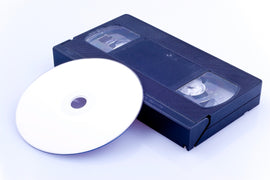
Kodak filed for bankruptcy on January 19, 2012. Once an iconic name synonymous with the way we captured memories, Kodaks' transformation failure should be a warning to all of us who value preserving photos & videos. Let's discuss the impact of Kodak's abandonment, heeding the sage advice to scan photos off aging film-based products without locking up our memories on obsolete technology, like DVDs.
The Kodak Legacy
Kodak, founded in 1888 by George Eastman, became a household name due to its innovations in film and photography. The company dominated the market, producing a staggering amount of film over the years, becoming synonymous with capturing life's special moments. The term "Kodak moment" even entered the vernacular, representing those picture-perfect instances worth preserving for a lifetime.
Blinded By Greed
Film-based products were never designed to last for lifetimes, and Kodak knew it. The company, blinded by its historical success, chose to ignore technological innovation that would have better served their customers. By irresponsibly failing to advance digital preservation of memories, consumers fled film, and Kodak, in pursuit of digital technology that would better suit them for generations.
Navigating the Future
As consumers, the bankruptcy of Kodak serves as a poignant reminder of the need to scan photos and convert film products. The transition to digital formats not only ensures the longevity of our cherished memories but also allows us to easily share and access them in an interconnected world. Not all technology is good, so it's critical to choose wisely when transitioning photos & videos into an enduring digital format.
Scan Photos
Photographic prints, photo slides, and picture negatives, made by companies like Kodak, will not last forever. Placing prints in photo albums doesn't help much, often risking further damage to remove the photos from the adhesive page or acetate plastic covering. Scan photos to a portal digital format, like a JPEG file, before they further deteriorate or get lost.
Convert Film
The cellulose acetate in 8mm, Super8, and 16mm film reels begins to break down in only 50 years. This affects all video film reels, including the most popular silent variety, and also the more expensive & rare film reels with sound strips. Convert film reels to a portable digital format, like an MP4 file, before they start to smell like vinegar from deterioration.

The Digital Imperative
In the wake of Kodak's bankruptcy, the importance of transitioning from traditional physical media into enduring digital formats has become increasingly apparent. Old film reels, photographs, and videos stored in obsolete formats risk being lost to time. Scanning photos & converting film requires a proactive approach to safeguard these artifacts before they degrade or get lost.
DVDs: Technological Obsolescence
While the imperative to scan photos & convert film to a digital format is clear, it's crucial to highlight the inadequacy of certain methods, such as transferring home movies & photos to DVDs. In an era dominated by cloud technology, DVDs are not only outdated, but also pose significant risks to the preservation of precious memories. Transferring precious memories to DVDs is a fool's errand because they'll eventually need to be rescued from these vulnerable plastic discs.

Poor Lifespan of DVDs
One of the primary drawbacks of relying on DVDs is their limited lifespan. DVDs are susceptible to deterioration over time, with factors like exposure to light, heat, and humidity hastening the degradation process. Scratches in these vulnerable plastic discs can sometimes be repaired, but a cracked DVD is lost forever
DVD Limited Storage
Transferring home movies & photos to DVDs is an inefficient and space-consuming process. DVDs have limited storage capacity compared to modern digital alternatives. This limitation can result in fragmented storage, requiring multiple DVDs for a sizable media collection, making organization and retrieval a cumbersome task.
Embracing Cloud
The adoption of cloud technology in 2007 revolutionized the way we redundantly store & securely share data. However, since that time, Legacybox has irresponsibly made DVDs that put your home movies & photos at risk for permanent loss. Businesses that cling to outdated practices in the face of technological progress, like Kodak, should not be trusted to preserve your priceless memories.
Preserve What's Precious
The story of Kodak's bankruptcy is a cautionary tale about complacency in the face of technological evolution. It also gives us pause to consider the things we hold dear: Photos & videos of our vacations, weddings, and other heartwarming moments. Let's embrace scanning photos & converting film to the cloud, so we can share the memories with friends & family for countless generations.
Select a box to get started.
This is the safest way to ship.
Pack whatever fits... we'll sort it all.
No minimum... pay unit digitizing prices.









